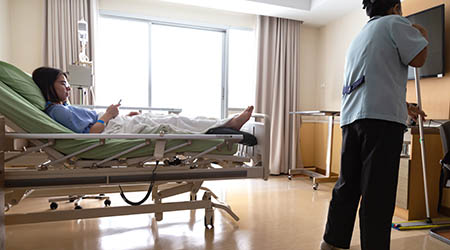Prevention is always better and less expensive than a cure, especially when the world is running out of antibiotics. It is imperative to develop a new and more efficient model for hospital environmental hygiene maintenance. Although many hospitals are quick to spend money on new software, specialized staff, and fancy equipment, they often look at maintaining a safe, clean, and disinfected environment as an opportunity to save in the budget.
Hospitals must realize that being a hospital “cleaner” is not a job but a profession and invest in their workforce. Hospital leadership and key stakeholders must work together to change how we maintain the hospital environment to better protect patients.
It is estimated that more than 50 to 70 percent of all healthcare associated infections (HAIs) are spread through contaminated hands. It is time to focus on the other 30 to 50 percent, a part of which might be linked to environmental transmission. After all, “hands are really just another highly mobile surface in healthcare that are commonly contaminated and rarely disinfected.”
We know that one of the modes of disease transmission is accomplished by touching a contaminated surface (we call these fomites) and then touching a mucous membrane (eyes, nose, or mouth). Infection prevention can be accomplished by following a structured and reproducible process every time patient-care equipment or area is hygienically cleaned.
Did you know that in many healthcare facilities there persists a view that considers hand hygiene separately from other cleaning and disinfection procedures?
Detergent-based cleaning of hands is seen to reduce contamination to a level considered as safe. But detergent-based cleaning of environmental surfaces, particularly in healthcare facilities (HCF) is regarded as the means to remove soil prior to application of a disinfectant.
The fact that, as with hand hygiene, cleaning itself contributes to achieving safety target levels on surfaces. A disinfectant kills microbes. However, depending on the pathogen, preventing the microbes from getting a foothold by removing food and moisture (two essentials for sustaining living organisms) may, in the long-term, be as effective as a chemical disinfectant.
Fear of infection encourages the use of powerful disinfectants for the elimination of real or imagined pathogens in hospitals. Not only do these agents offer false assurance against contamination, but their disinfection potential also cannot be achieved without the prior removal of organic soil.
The guiding principle is always to remove germs if possible, rather than kill them, and then, when necessary, use the least amount of the mildest chemical because stronger often means more toxic to humans and the environment.
The efficacy of hygiene procedures involving removal (e.g., detergent-based cleaning) is rarely (if ever) compared with those involving inactivation (e.g., disinfectant use) even though both are intended to produce the same result. Detergent-based cleaning is cheaper than using disinfectants and much less toxic to humans and is less corrosive to surfaces. If hygiene procedures are to deliver real health and safety benefits, we need a consistent approach based on scientific principles, which can be applied across all settings.
J. Darrel Hicks, BA, MESRE, CHESP, Certificate of Mastery in Infection Prevention is the Past President of the Healthcare Surfaces Institute. Hicks is nationally recognized as a subject matter expert in infection prevention and control as it relates to cleaning. He is the owner/principal of Safe, Clean and Disinfected. His enterprise specializes in B2B consulting, webinar presentations, seminars and facility consulting services related to cleaning and disinfection. He can be reached at darrel@darrelhicks.com or you can learn more at www.darrelhicks.com.

 Building Disaster Resilience Through Collaboration
Building Disaster Resilience Through Collaboration Amae Health Expands to New York City
Amae Health Expands to New York City Hospital for Special Surgery Opens Two New Facilities in New Jersey
Hospital for Special Surgery Opens Two New Facilities in New Jersey Should We Be Testing Toilet Water in Patient Restrooms?
Should We Be Testing Toilet Water in Patient Restrooms? Healthcare Union Petitions for Increased Staff Safety at HCA Florida Hospitals
Healthcare Union Petitions for Increased Staff Safety at HCA Florida Hospitals